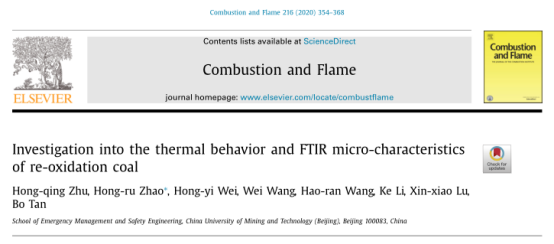赵鸿儒,12BET官方网2020届硕士毕业生,中共党员。曾获北京市优秀毕业生、北京市优秀员工干部、中国安全生产协会安全科技进步一等奖、创青春全国老员工创业大赛三等奖、首都高校老员工创业大赛三等奖、12BET优秀研究生、12BET优秀团学干部等多项荣誉。硕士期间共发表学术论文9篇,授权国家专利4项。目前已被清华大学核能与新能源技术研究院录取为2020级博士研究生。
1、仰望星空,脚踏实地

2013年9月,怀着对首都的向往,怀着对大学的渴望,赵鸿儒来到了12BET资源学院。作为一名员工,他深知勤奋刻苦是优秀员工的标准,在本科期间,他学习踏实认真,多次获得学业奖学金,同时积极投身员工工作,曾担任12BET资源学院员工会主席、12BET员工委员会委员。在三年的员工工作生涯里,他时刻保持对员工工作的热情,坚持务实、高效的工作作风,保持基础性工作的扎实到位,圆满组织策划了员工会的各项活动,得到了老师、同学的高度认可。2016年他被评为北京市优秀员工干部、12BET优秀团干部。同时所参与组织的创业项目也分别获得首届创青春全国老员工创业大赛三等奖(2016年)、首都高校老员工创业大赛三等奖(2016年)等奖励。
2、立志科研,不忘初心

12BET安全科学与工程学科属于全国双一流建设学科,拥有先进的科研设备、优秀的团队队伍和丰富的科研成果。2017年9月,赵鸿儒经过深思熟虑选择继续在12BET攻读安全科学与工程硕士学位,并选择热门的消防工程与火灾科学方向,师从朱红青教授。从硕士刚入学开始,朱老师便根据他的专业基础及研究兴趣,为他确立了煤自燃机理与矿井火灾防治的研究方向,制定针对性培养方案。在朱老师的悉心指导以及鼓励下,他坚定了信念,潜心科研,认真学习,不懈努力,在学业和科研上实现了自我的价值,取得了优秀成绩。同时,朱老师为他提供多次科研实践机会,他主动请缨,深入煤矿井下测试数据,以员工负责人的身份在老师指导下圆满完成企业合作课题2项和作为主要完成人参与企业合作课题3项。
他潜心钻研,勇于探索,发表多篇学术论文与专利。硕士期间共发表学术论文9篇,其中以员工第一作者身份发表SCI论文1篇(Combustion and Flame,Top,中科院一区)、EI论文1篇(煤炭学报)、中文核心论文2篇,以共同作者身份发表SCI论文5篇。共授权国家专利4项,其中发明专利3项,实用新型专利1项。
3、精益求精,厚积薄发

仰之弥高,钻之弥坚。赵鸿儒硕士期间对煤发生初次氧化后的复燃过程进行了深入的研究与探讨。为了保证实验的准确性,他将实验流程烂熟于心,实验开始前会充分考虑各种实验过程中可能出现的情况,对实验方案进行反复的推敲,与朱老师及课题组老师和同学深入讨论,确保实验方案的合理性,真正做到精益求精,这正是科研人应具有的品质。为了顺利完成实验,他经常伴着凌晨一两点的月光回宿舍,也经常在天没亮之前回矿井火灾防治实验室继续完成实验。正是凭着这种对于科研的无限热情与不懈追求,他最终完成了一篇高水平的学术论文《Investigation into the thermal behavior and FTIR micro-characteristics of re-oxidation coal》,并在国际燃烧领域权威期刊Combustion and Flame发表。
“雄关漫道真如铁,而今迈步从头越”,清华大学将是这位矿大学子学习与科研道路上的又一个新的起点,愿他在未来的征程中不忘初心创造新的辉煌!

Abstract(摘要):
To investigate pore structure, free radical concentrations, thermal behavior and FTIR micro-characteristics of the re-oxidation coal, we used Scanning Electron Microscope (SEM), Electron Spin Resonance (ESR), Fourier Transform Infrared Spectroscopy (FTIR), and a Synchronous Thermal Analyzer (STA). We conclude that the extension of pores and micropores on the coal surface due to initial oxidation, lead to an increase in the combination of coal and O2 in the re-oxidation of coal (ROC). Moreover, as the initial degree of oxidation increases, the number of aliphatic hydrocarbons and hydroxyl groups show a decreasing trend, while the content of oxygen-containing functional groups (–COO–, C=O, COOH) and free radical concentrations increase significantly. Differences between the aliphatic hydrocarbon content in raw coal, 80°C-Y coal (i.e., coal pre-oxidized at 80°C for 30 min) and 180°C-Y coal are small. However, the content of aliphatic hydrocarbons in 280°C-Y coal decreased sharply from 35.26% to 25.83% compared to that of 180 ºC-Y coal. The free radical concentrations of the 380 °C-Y coal increased by 9.84% compared to the raw coal. The initial oxidation can directly increase the free radical concentrations of coal, and promote the oxidation reaction of the re-oxidation coal. The consumption of combustibles during initial oxidation results in the rate of ROC being slower than the oxidation of raw coal. With the increase in the degree of initial oxidation, these changes become more obvious.
